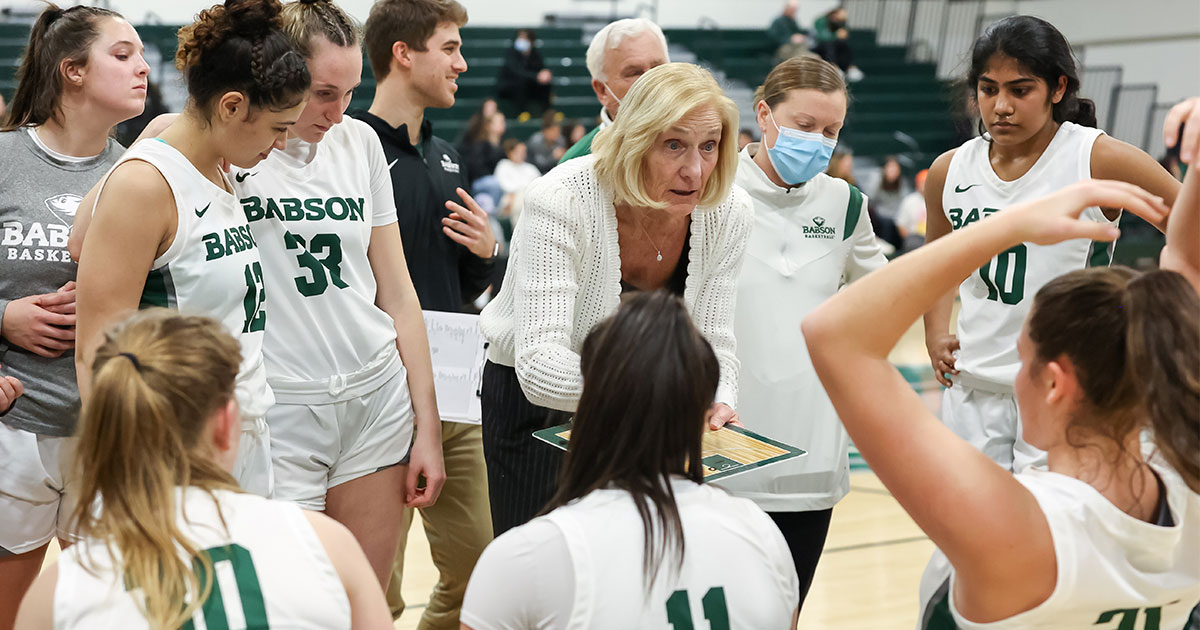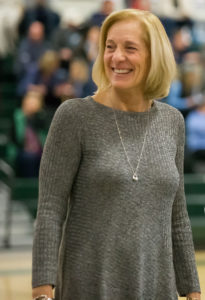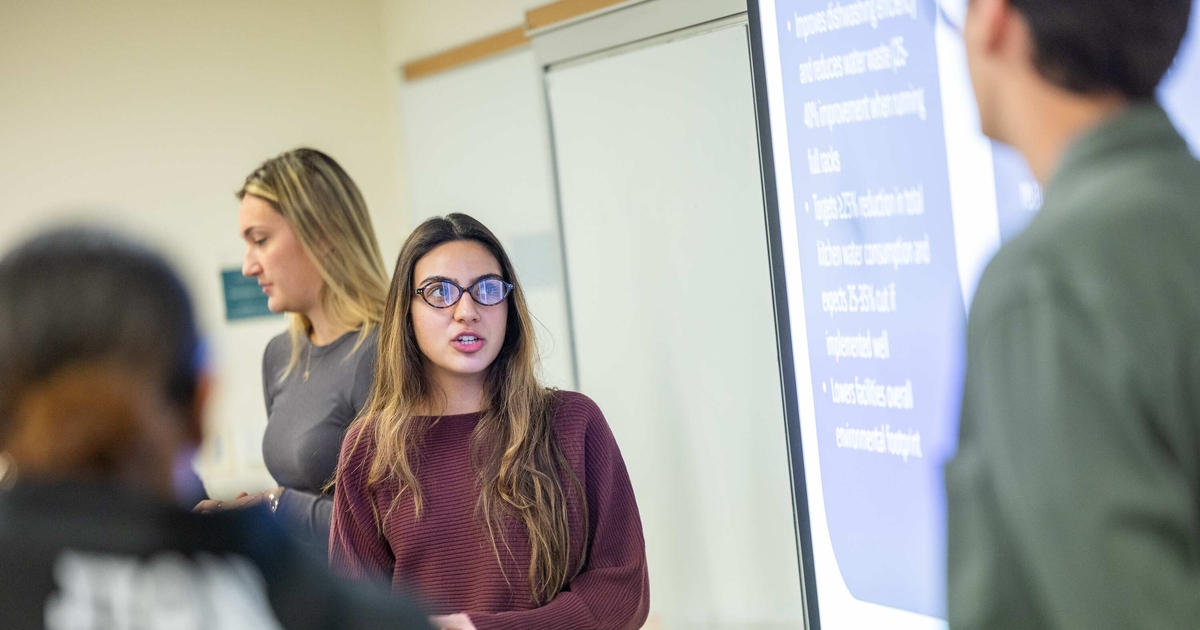Reflecting on Title IX as Women’s History Month Begins

When longtime basketball coach Judy Blinstrub arrived at Babson College in 1984, recruiting female athletes came with a unique set of challenges.
At the time, Babson’s undergraduate population was only about 18% female. That meant that, in order to have enough athletes to field teams, Blinstrub tried to recruit students who ideally would play more than one sport. Often, they played three, one for each season of the school year.
Parents proved another challenge, some of them questioning why their daughters should even go to business school and play a sport, when they would just end up marrying anyway. What would come of their pricey education, the parents wondered.
That mindset was slow to change. “Eventually, parents figured out college was the right thing for female athletes, but that took a long time,” Blinstrub says.
This year marks the 50th anniversary of Title IX, the landmark civil rights law that bans gender discrimination in education programs receiving federal funding. The law’s legacy is felt particularly in athletics. In 1971, the year before Title IX passed, only 15 percent of college athletes were women. Today, that percentage has jumped to 44 percent.
In her 38 years as head coach of the Babson women’s basketball team, not to mention the 20 seasons she spent as women’s soccer head coach from 1984 to 2005, Blinstrub has witnessed the impact of Title IX firsthand. On the eve of Women’s History Month, she took time to reflect on how, slowly but surely, women’s athletics has been transformed. Facilities have improved, attitudes have changed, and the number of female athletes and coaches has multiplied.
“It opened so many doors,” says Blinstrub, who also has served for 35 years at Babson as a women’s athletic administrator and is currently senior associate director of athletics. “You see how much the opportunities have grown.”
For all the good that Title IX has caused, though, Blinstrub also is quick to caution that more work still needs to be done.
History and Memory
Blinstrub’s office sits in the Webster Center on Babson’s campus. Out one window, she can see the indoor track, which circles the Staake Gymnasium, a place she has spent an inordinate amount of time through the years. Out the other window, she can see far into the distance, to the tops of the tallest skyscrapers of Boston.

Judy Blinstrub has witnessed changes brought by Title IX, not only as a coach, but also as an administrator. She has spent 35 years as an athletic administrator at Babson and served as acting athletic director for a time.
Her office is a place filled with history, the walls covered with recognitions and photos of the many athletes she has coached. When Blinstrub looks upon those walls, she can’t help but wade into memory. “I think of all of the women I have connected with and coached,” she says. “I have stayed in touch with lots of them. I am still really close to the first group of women I coached here. They are some of my closest friends now.”
Blinstrub arrived on campus just about a decade after Babson fielded its first women’s varsity team, which was in basketball. That trailblazing group, many of whom didn’t have any prior basketball experience, played five games their first season in 1974 and 1975 and lost them all.
However, that team (along with four women swimmers who competed that season with the men’s swimming and diving team) paved the way for all the women athletes who followed at Babson. Today, 178 female athletes compete with 11 varsity teams at the College.
Through her years at Babson, Blinstrub has witnessed the growth of women’s sports. She also has experienced challenges, particularly during her early years at the College, as women sought an equal footing with men.
Soon after arriving, for instance, she questioned why women athletes couldn’t practice on their regular game facilities but instead had to trek down to fields that are now part of nearby Olin College. She also wondered why women were forbidden from using the weight room, as if the notion that women might want to strength train was a foreign idea. “They wanted to lift,” Blinstrub says. “They wanted to get stronger for their sports.”
Both of these situations were soon rectified.
A Strong Network
Though the exact percentage varies every year, Babson’s undergraduate population is roughly half female nowadays. Blinstrub says women’s sports played a role in achieving that, as the process of athletic recruiting casts a large net for students. “Some you recruit don’t end up playing sports, but they come to Babson anyway,” Blinstrub says.

Judy Blinstrub (center) says her former players have formed a strong alumni network and offer their support and guidance to current players.
In the 1990s, Blinstrub first met with admissions and asked them to start targeting more female athletes. They are leaders, she argued. They are active and engaged on campus. “It has been a good relationship with admissions,” Blinstrub says. “We’re helping the College as much as they are helping us athletically.”
This isn’t to say that the work of achieving gender equality in the wider world of college athletics is finished. “It is still in the process,” Blinstrub says. “There is still a way to go.” Consider the blaring disparity in men’s and women’s weight rooms at last year’s NCAA basketball tournaments, or how college female coaches often don’t make as much as their male counterparts. “If you’re good—male or female—you should get what you deserve,” Blinstrub says.
As more and more women athletes have come to Babson’s campus through the years, though, Blinstrub has seen what the strength of their numbers has led to, whether that’s expanded facilities (gone are the days when women’s teams didn’t have dedicated locker rooms) or better transportation (Babson’s women’s teams finally swapped their vans for buses in the 1990s).
All of those athletes form a strong and supportive alumni network. “I love when the alumni reach out to the present students,” Blinstrub says. “They talk about what it’s like to leave Babson and enter the real world.”
Blinstrub also loves how her current players, in turn, serve as role models to girls. That was particularly true before the pandemic, when children would play basketball at halftime and players would take time to hang out with them. “They look up to our players, who become role models to younger generations,” Blinstrub says. “I think it’s great.”
Posted in Community






